Ultimate Ropa Vieja
This post may contain affiliate links. See my disclosure policy.
The ultimate version of one of Cuba’s most famous dishes, this Ropa Vieja recipe is positively PACKED with flavor!! A myriad of flavorful ingredients and spices come together to make this dish truly unforgettable. Make a double batch while you’re at it and you’ll be glad you have the leftovers (plus it freezes well). A reader favorite, check out the hundreds of rave reviews below!
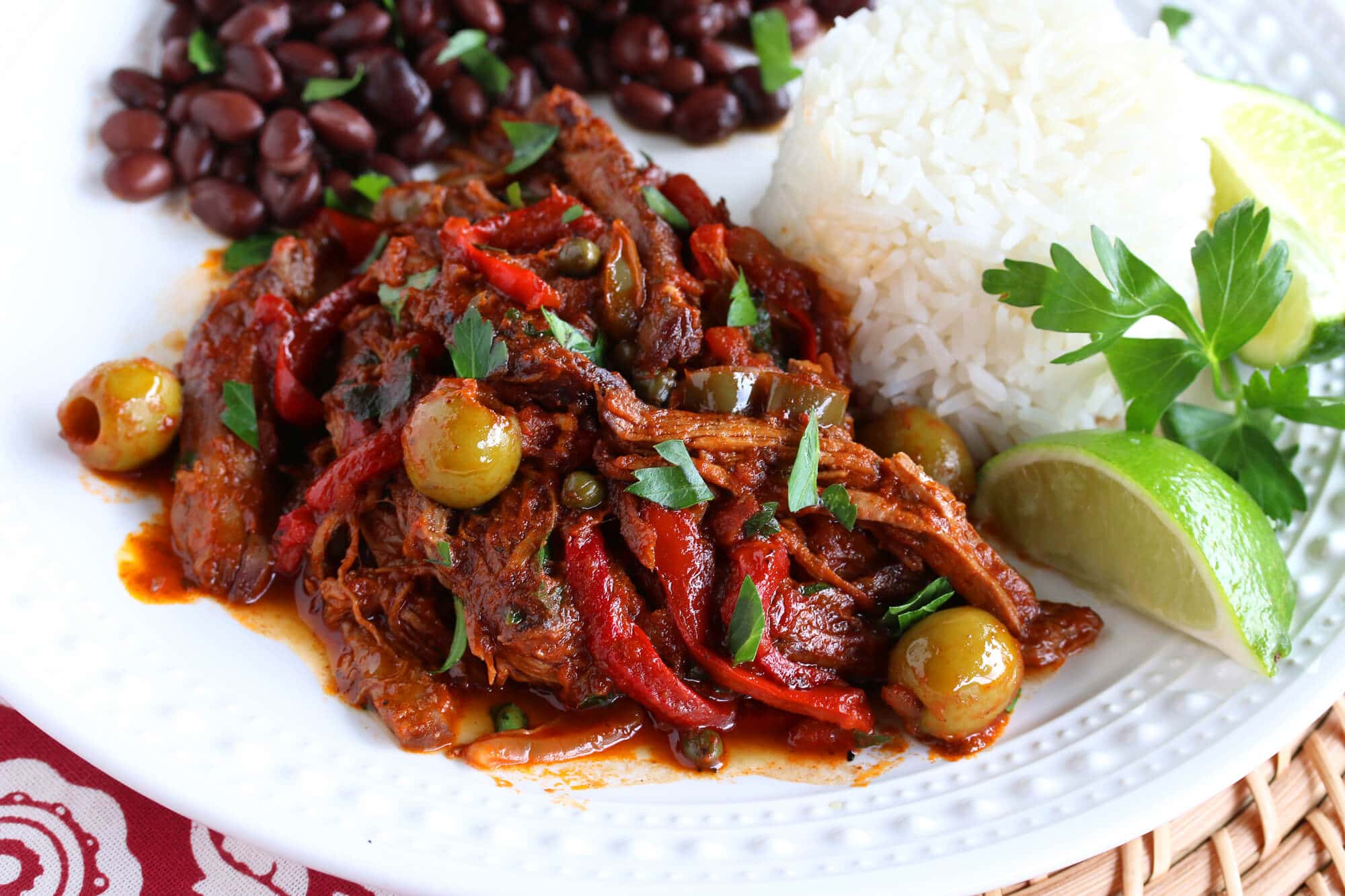
What is Ropa Vieja?
Shredded beef and vegetables that resemble a heap of colorful rags – that’s Ropa Vieja. From the Spanish term for “old clothes”, this is one of Cuba’s most popular and beloved dishes. So popular in fact that it’s one of the country’s designated national dishes.
This dish dates back to the Middle Ages of Spanish Sephardi, a loose adaptation of a dish that remains popular in southern and central Spain. Traditionally it was a way to stretch the leftovers of stews such as puchero or cocida, both of which are garbanzo-based dishes as is the original Spanish version of Ropa Vieja. This dish was later taken to Cuba where the Cubans made it their own.
Central in this dish are beef and tomatoes, both naturally umami-rich ingredients. Added to that are zesty bell peppers, caramelized onions, and to that we’re going to add some additional ingredients and spices that will make your taste buds sing with joy!
How to Make Ropa Vieja
Today we’re going to make some ultimate Ropa Vieja with a wonderfully rich depth of flavor! In the end you’ll have to make your own judgment call, but I’m pretty confident you’re going to love it (just check out the hundreds of rave reviews below)!
The traditional method for making ropa vieja involves simmering the beef in water, shredding it, and then adding it to the sauce. I’m going to show you a shortcut that not only saves time but results in a more flavorful dish. We’re going to sear the beef and then simmer it directly in the sauce, then shred it. This way all those flavorful juices from the beef go directly into the sauce. And it saves time. It’s a win-win. To mimic the extra step of making a separate stock, we’re also going to add whole carrots, celery and bay leaves and then discard them at the end, infusing the sauce with some umami qualities and natural sweetness from the vegetables.

Ropa Vieja Ingredients
For our ultimate ropa vieja recipe we’re adding an array of other classic Cuban and Spanish ingredients such as olives, pimientos and capers. In addition to the red bell pepper that’s caramelized with the onions, we’re also going to add roasted red bell pepper in the end for added smokiness, sweetness and flavor.
You may be wondering, “what’s the difference between pimientos and red bell peppers? Aren’t they the same thing?” A pimiento, also called pimento or cherry pepper, is a variety of red chili pepper that is sweeter and more aromatic than red bell peppers (though some varieties of pimientos are hot). They add a nice element of natural sweetness and flavor to this dish.
What is the Best Cut of Beef to Use?
Traditionally Ropa Vieja is made with flank steak. Have a look around the internet at all the ropa vieja recipes and virtually all of them call for flank. That piqued my curiosity because here’s the thing: Flank steak is from the bottom hard-working muscle area of the cow (ie, very lean/very little fat) so it not only has less flavor than some other cuts of beef, it’s also notoriously tough.

Because of its low fat content, flank steak is best suited to very quick, high heat cooking, like grilling. It’s not the best choice for braising or slow cooking because without the fat content and connective tissue it dries out during the cooking process. For all of these reasons flank steak used to be one of the cheaper cuts of beef. But in recent years the price has sky-rocketed and in many places is double the cost of chuck. But flank still continues to be used in nearly all ropa vieja recipes out of tradition because of its shape – the grains of the cut yield long strands of shredded beef resembling the dish’s namesake, torn clothing.
Flank steak is unique in that respect with those long tough strands. But I wasn’t willing to sacrifice tenderness, flavor or cost for the sake of having long shreds of beef. So I went to three different butcher shops and chatted with their butchers. First I wanted to see their reaction when I told them I was looking for flank steak for a low and slow-cooked dish. All three raised their eyebrows and asked me why on earth I’d want flank steak for that. They all shook their heads and said that, hands down, the best choice for slow-cooked shredded beef was chuck. Better texture, better flavor and at nearly half the price of flank.
Chuck works so well for slow cooking because the long cooking time over low heat breaks down the cartilage, melts the fat and keeps the beef moist while also adding a ton of extra flavor. It’s by far the most popular beef cut of choice for slow cooking and shredding. So what about the aesthetics element, those long strands of beef you get from the flank steak? Chuck has short strands that after slow cooking and shredding typically look less pronounced and are mushier. The way around that: Simply ask the butcher to cut you a piece of chuck that is taller than it is wider (the height running with the direction of the grains). That way you’ll get longer strands along with a deliciously flavorful, tender and moist shredded beef.

Can I Make it in a Slow Cooker?
Yes! You’ll still want to sear/brown the roast first because this is essential for the best flavor. Likewise follow the instructions to saute the veggies. Then transfer the ingredients over to the slow cooker and cook on LOW for 6-8 hours or on HIGH for 4-6 hours or until the beef is tender. Remove the veggies and bay leaf and follow the instructions in Step 3 to add the final ingredients.
Can You Freeze It?
Yes! Ropa vieja freezes well. Freeze it in a freezer-safe container or freezer bag for up to 3 months. Remove it from the freezer, let it thaw in the fridge overnight, and slowly reheat it on the stovetop, in the oven, the microwave, or slow cooker.
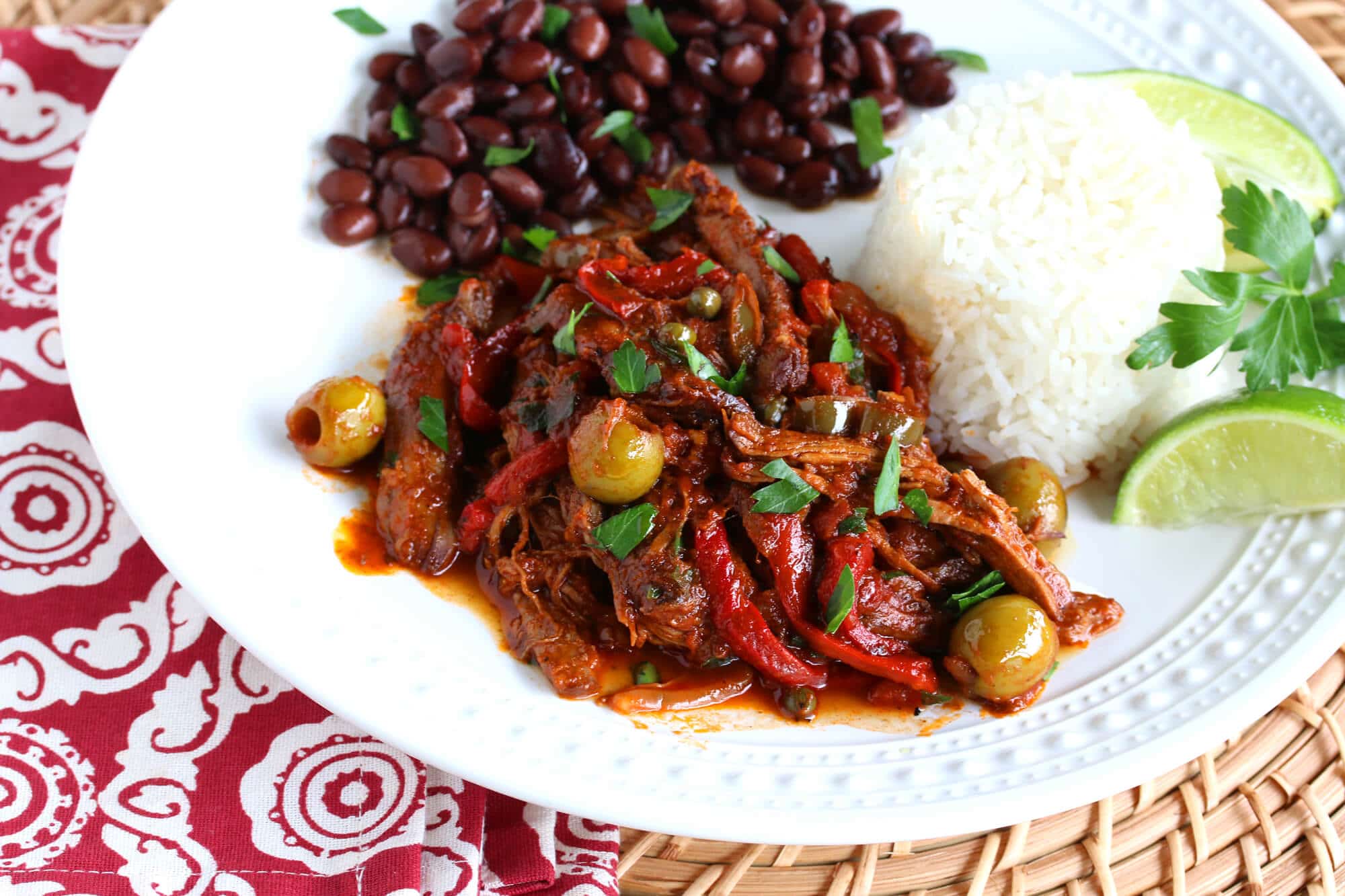
Ropa Vieja Recipe
Let’s get started!
Pat the beef dry and sprinkle with salt and freshly ground black pepper. Heat the oil in a Dutch oven over high heat. Once very hot add the beef and brown generously on all sides. I’m using my Le Creuset Dutch oven. I also have the Lodge Dutch oven that is a fraction of the price and I love them both.
Transfer the beef to a plate. Do not discard the drippings and blackened bits in the pot, they are key to the flavor.
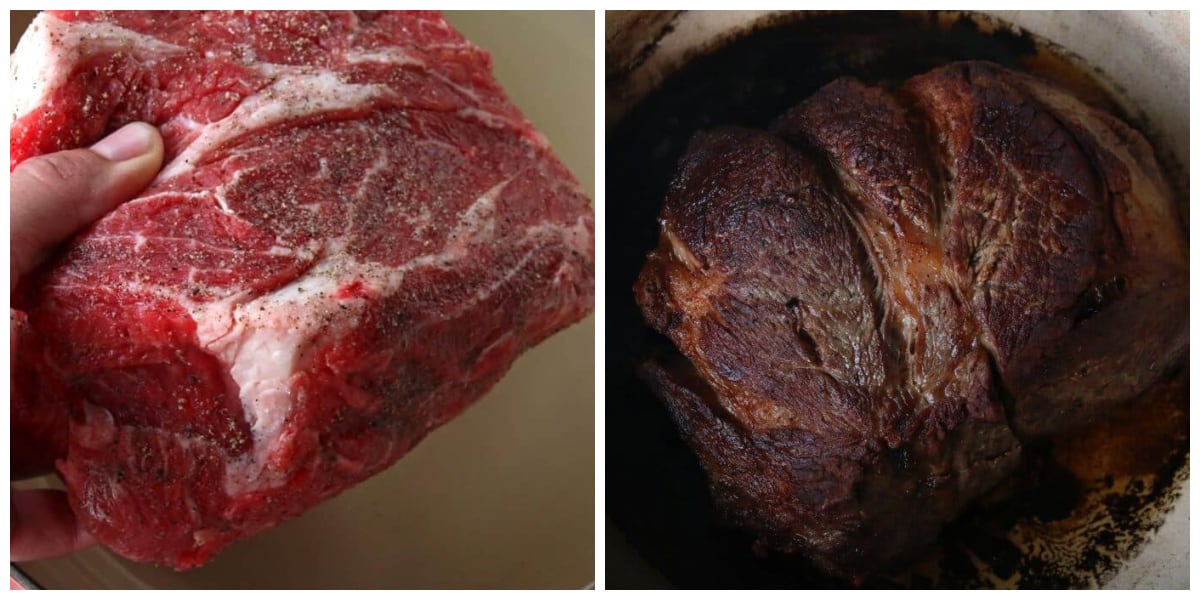
Add the sliced vegetables to the pot and cook over medium heat for 15-20 minutes until caramelized.

Add the garlic and spices and cook for another minute.
Add the white wine and bring it to a rapid boil, deglazing the bottom of the pan (scraping up the browned bits on the bottom of the pan).

Add the broth, crushed tomatoes, tomato paste and bay leaves. Simmer for 5 minutes.
Return the roast to the pot along with the pieces of carrots and celery. Bring to a boil, reduce the heat to low, cover and simmer for 3-4 hours or until the beef is fork tender and falls apart easily.
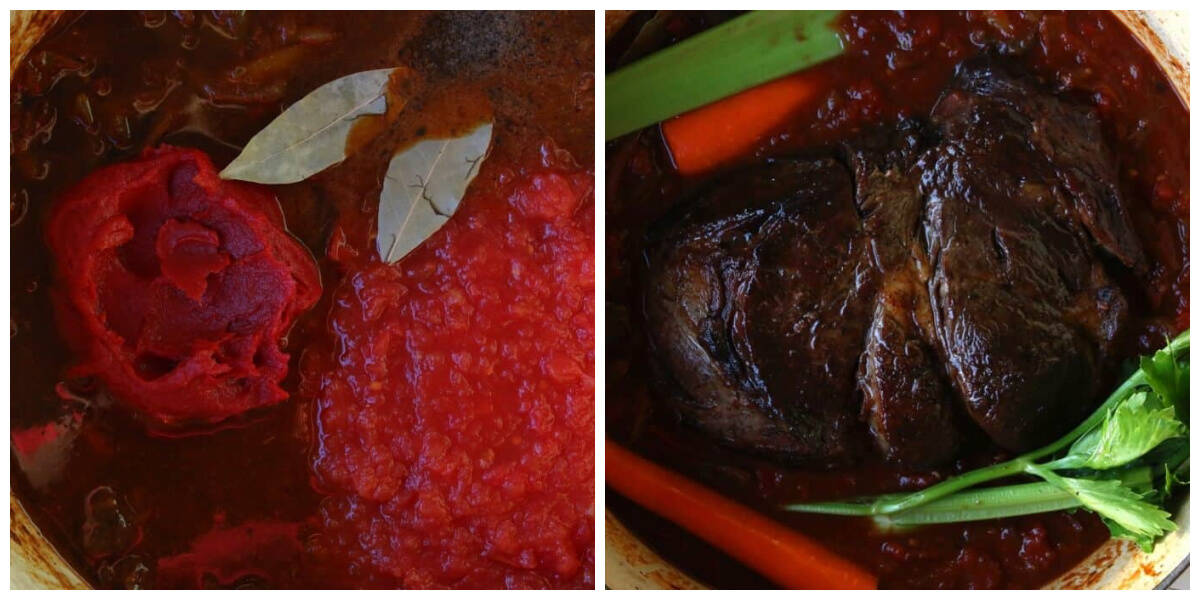
Discard the celery, carrots and bay leaves.
Transfer the beef to a plate and shred it with two forks.
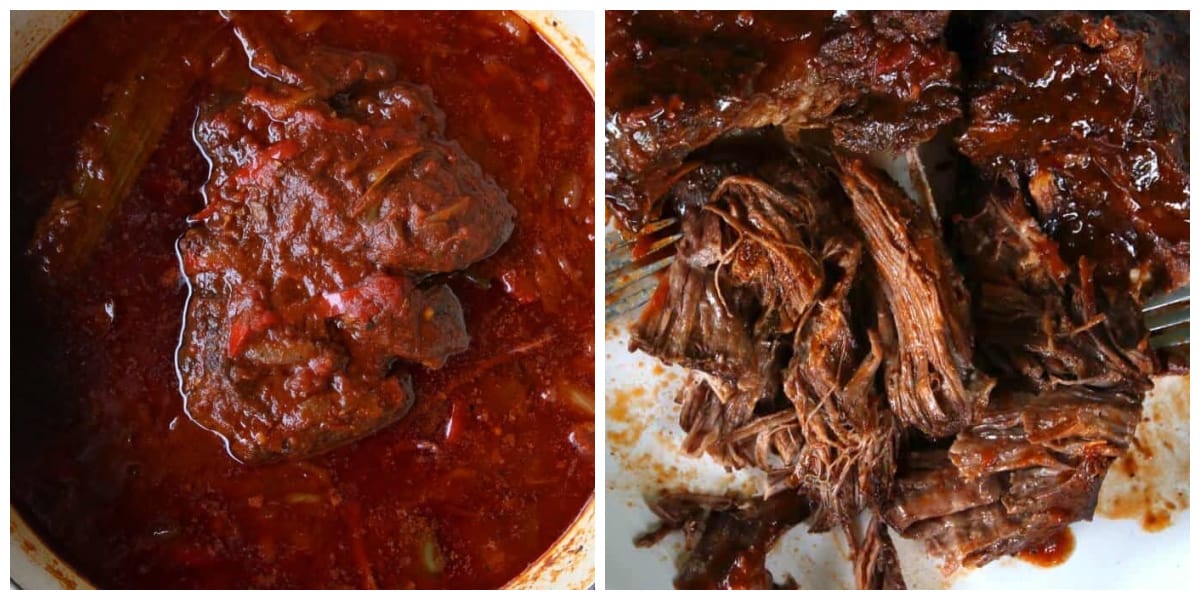
Return the shredded beef to the sauce. Stir in the olives, roasted red peppers, capers and pimientos. Simmer uncovered to thicken the sauce for 30 minutes.
Stir in the parsley. Add salt and pepper to taste.
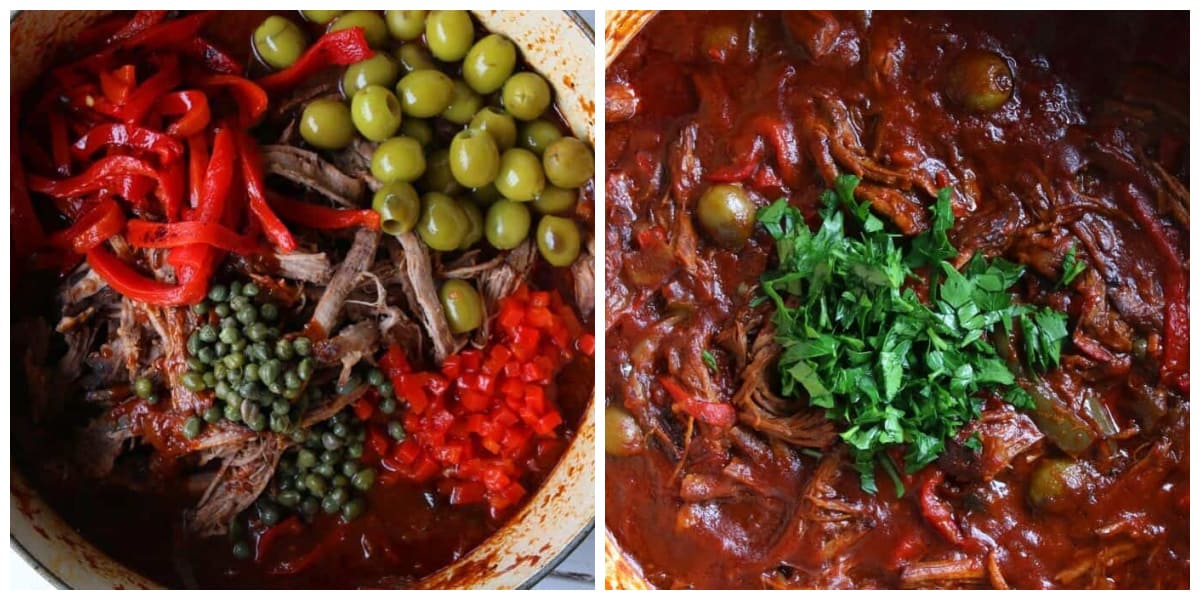
Your Ropa Vieja is ready to serve.
And its flavor only improves the next day if you can be patient enough to wait!
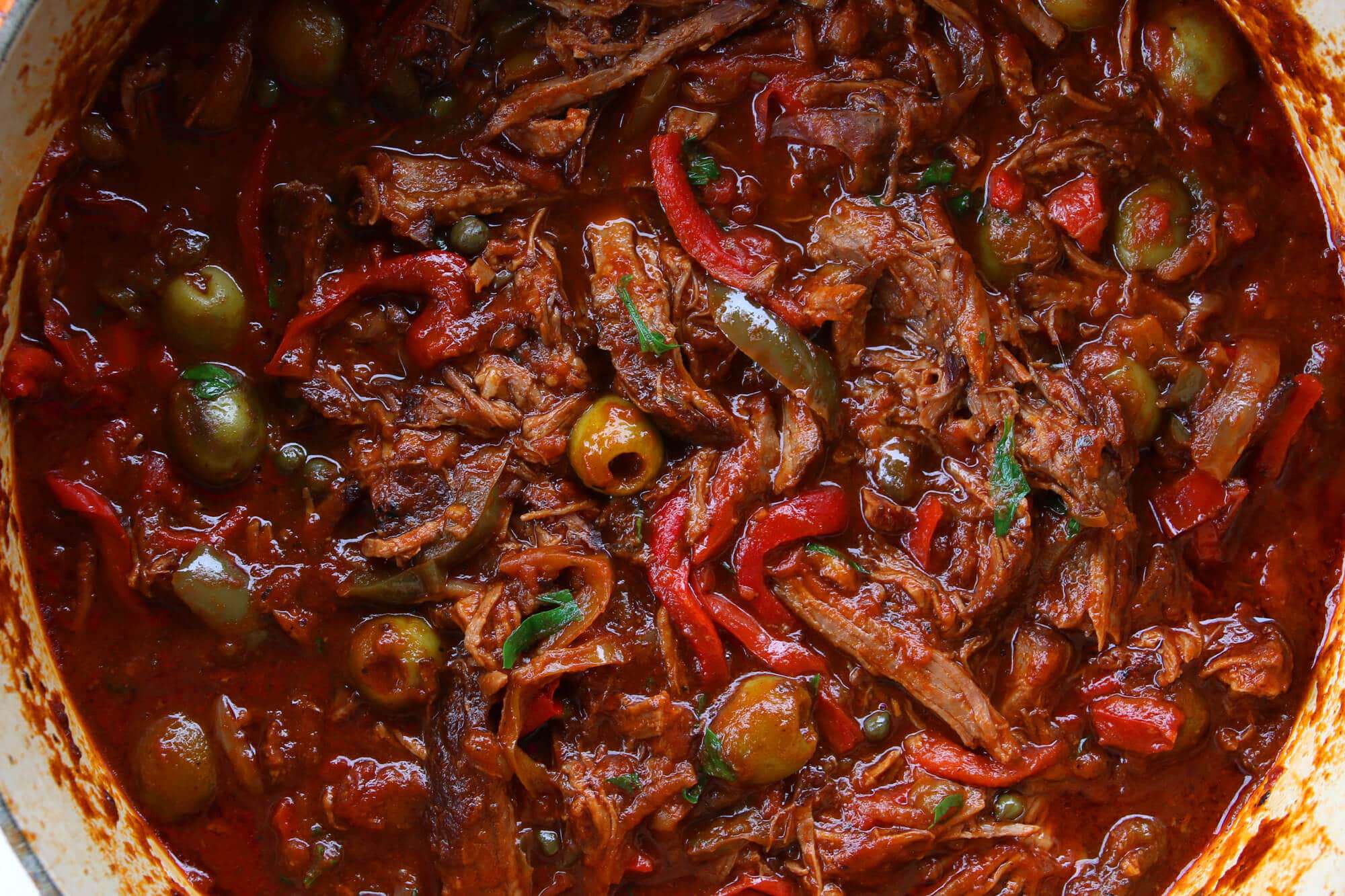
Serve with steamed or yellow rice and black beans. And for an additional treat, include some crispy homemade Tostones!
Ropa Vieja only tastes better the next day as the flavors have more time to meld, so this is a perfect dish to make in large batches for leftovers!
Enjoy!
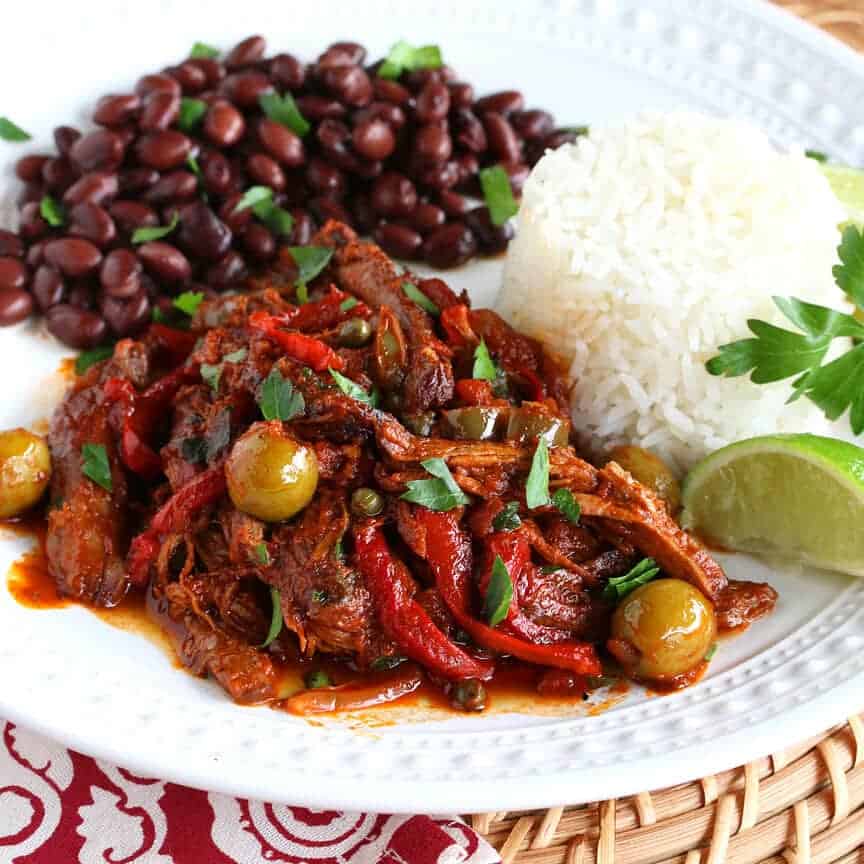
For more incredible beef stews from around the world be sure to try my:
- Guinness Stew
- Hungarian Goulash
- Sega Wat (Spicy Ethiopian Beef Stew)
- Pörkölt (Hungarian Beef and Onion Stew)
- German Goulash
- BEST Beef Stew
- Pichelsteiner
- Beef Bourguignon
- Hachee (Dutch Beef and Onion Stew)
- Domoda (Gambian Peanut Stew)
Save This Recipe
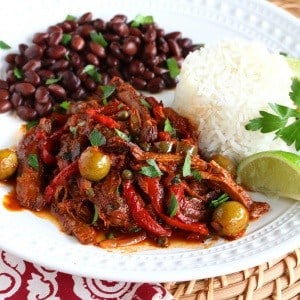
Ultimate Ropa Vieja
Ingredients
- 2 pounds chuck ask your butcher to cut it taller than wider so you get long strands of beef along the grain. OR you can use flank steak (see discussion in this post about cuts of beef and why we recommend chuck over flank)
- 1 large yellow onion thinly sliced
- 1 of each large green red and yellow bell pepper, thinly sliced
- 4 cloves garlic minced
- 2 teaspoons dried oregano
- 2 teaspoons ground cumin
- 2 teaspoons sweet paprika
- 1 teaspoon smoked paprika
- 1/8 teaspoon ground allspice
- 1/8 teaspoon ground cloves
- 2 teaspoons kosher salt
- 1/2 teaspoon freshly ground black pepper
- 1/2 cup dry white wine
- 1 cup chicken broth
- 16 ounce can crushed tomatoes
- 6 ounce can tomato paste
- 2 bay leaves
- 1 large carrot cut in half
- 1 large stalk celery cut in half
- 1 cup green olives , rinsed and drained (you can slice them if you prefer)
- 1/2 cup roasted red peppers , drained
- 1/4 cup pimientos , drained
- 2 tablespoons capers , rinsed and drained
- 1/3 cup chopped fresh parsley
Instructions
- Pat the beef dry and sprinkle with salt and freshly ground black pepper.Heat a little oil in a Dutch oven over high heat. Once very hot add the beef and brown generously on all sides. Transfer the beef to a plate. (Do not discard the drippings and blackened bits in the pot, they are key to the flavor.)Add the sliced vegetables to the pot and cook over medium heat for 15-20 minutes until caramelized. Add the garlic and spices and cook for another minute. Add the white wine and bring it to a rapid boil, deglazing the bottom of the pan (scraping up the browned bits on the bottom of the pan).Add the broth, crushed tomatoes, tomato paste and bay leaves. Simmer for 5 minutes.
- Return the roast to the pot along with the pieces of carrots and celery. Bring to a boil, reduce the heat to low, cover and simmer for 3-4 hours or until the beef is fork tender and falls apart easily. Discard the celery, carrots and bay leaves.
- Transfer the beef to a plate and shred it. Return the shredded beef to the pot.Stir in the olives, roasted red peppers, capers and pimientos. Simmer uncovered to thicken the sauce for 30 minutes. Stir in the parsley and add salt and pepper to taste.
Notes
Nutrition
Originally published on The Daring Gourmet June 27, 2016



















If using pork what cut do you recommend? And would the amount of meat/cooking times be the same?
Hi Danae, pork shoulder is probably most commonly used for shredding and the cooking time would be about the same. Check it after 3 hours for tenderness to determine if it needs to cook longer.
I just finished making the ropa vieja for my family and they loved it! I followed the recipe and the directions exactly and it came out delicious! Thank you so much! 😋
Wonderful, I’m thrilled to hear that, thank you!
Hi, this sounds like it will be good, but as beef is not available for the average Cuban to eat do you know what meat they use instead? I was thinking of trying it with pork shoulder roast. What do you think?
P.S. Love your blog!
Hi Gregg, thank you! Beef is what has traditionally been used in Cuba for this dish. But under circumstances of late, meat of any kind, along with many other foods, are hard to come by. So I’m sure that Ropa Vieja is a now a rare luxury in Cuba. For Cubans living in the U.S. beef is still what is used.
Anyone else have trouble shredding the beef? Smells delicious, but it’s been cooking almost four hours and still not at all shreddable. Got some hungry kids here.
Greetings, Kimberly. I am looking forward to trying this recipe just as soon as I possibly can. As odd as it may sound, I am thinking of making it as our family Easter Dinner, just to have something different from the usual turkey and ham. However, as soon as I first read the recipe, I said to myself, “Self, forget the rice, this would be unspeakably delicious spooned over a thick slab of crusty country bread that has been darkly toasted and slathered in butter . . . ” But that’s just me. Like another reviewer, I too would cringe at the idea of discarding the carrots and celery. In my kitchen, they would go into my freezer as potential soup or sauce ingredients. I am 68 years old, and was raised on the philosophy of, “Use it up, wear it out; make it do, or do without.” And also, “Waste not, want not.” Thank you for your time and trouble in sharing this very tempting recipe. By the way, on speculation alone, I would rate your recipe with five stars, but I’m not sure if you want that, or to have me come back and rate it after I try it for real, and not just in my imagination . . .
Hi Patricia, I think serving Ropa Vieja for Easter sounds like a wonderful idea! We had the same discussion this past Thanksgiving and Christmas about being “turkey’d” and “ham’d” out and going for something completely different. And served over toasted crusty country bread slathered in butter? Marvelous. I share the same philosophy as you – the “discarded” vegetables used to make a base sauce like this are always eaten on the side with the rest of the meal. Once you’ve tried this dish, yes, please do come back and rate it – thank you!
Since you want a shredded consistency, have you thought of using brisket? I wonder if that is the cut originally used by the Sephardic immigrants who brought the dish to Cuba.
Hi Lindsey, yes, brisket is generally a good choice for slow cooking and shredding, it’s just that it creates short shreds instead of the long strands that are the preferred look for ropa vieja.
Looking at your recipe and the comments got me thinking. I will have to try using the chuck to see how it compares. Everyone in my family uses flank steak. I think my grandma’s recipe was the best, but that is what I grew up with. Many of the ingredients you have used I have never seen used in Ropa Vieja in the past. Doesn’t mean others don’t traditionally use those spices/ingredients, just means my family hasn’t. Wouldn’t it be boring if everything was the same? Some unsolicited advise for your Cuban/Cuban-inspired recipes: keep the raw onions and bell peppers; and use red, orange, and yellow bell peppers instead of green. The raw veggies impart a much needed layer of flavor. Over the years I have learned to partition the onions into thirds. I will carmelize 1/3, sweat 1/3, and leave 1/3 raw for the stewing/cooking process. The melded flavors give you the complex flavors you are wanting while bringing back the raw flavors that are necessary to stay true to the original ingredients. The omission of the green bells are purely preference since they are strong and caustic. My family uses reds for their Cuban dishes.
This is a quintessential Cuban dish even though it did not originate in Cuba. The number of variations in Cuban/Cuban-American families is probably as numerous as red sauce variations in Italian/Italian-American families.
Hi Richard! Yes, flank steak is what’s normally used, I simply deviated for the reasons I mentioned in my post. My personal preference is the richer flavor that comes from the higher fat content of chuck, but that certainly isn’t to say that flank steak doesn’t also taste good, it does. And yes, some of the ingredients in my version are not found in traditional Cuban ropa vieja – hence the term “ultimate” because it includes some ingredients that really give this already wonderful dish just that much more flavor and also makes it visually more interesting. Thanks for sharing your process! I agree, in many dishes it isn’t even the ingredients so much that make the difference as the technique involved.
I totally agree with using the colorful ‘orange pepper’ instead of the green! For years now I can not eat the green – they assault my stomach & intestinal tract! But I can and do eat the red, yellow & orange with no problems. Many people do not truly realize that as the peppers, like other vegetable color changes, grow & change their colors the chemical properties, nutrients change. As for the Thanksgiving holiday dinner – my mother would make the most fantastic large roasted goose stuffed with apples & oranges, herbs & spices (different mixes) or a large roast of lamb with garlic, herbs, & mint jelly! yum, yum My mother was full German, one grandma was full Italian, the other German with many Hungarian influences and with others that visited – we had FOOD of all sorts in that house growing up!!
Pat, I can just imagine the wonderful cooking that took place in that home with all those wonderful culinary influences! And what I wouldn’t do to sit down to a marvelous goose dinner like that again (my Oma in Stuttgart used to make goose for Christmas). It’s near impossible to even find goose here in the U.S. I’ll have to look into special ordering one at some point. Thanks for sharing, Pat!
I lived in Fort Lauderdale for about 40 years. I miss eating ropa vieja at Don Arturo Cuban restaurant but I now live in the Philippines I guess I have to cook it myself. We do not have black beans to go with it though. Yummmm. Oh well. My loss!
Hi Faye, yes, you’ve got to try this! It will be wonderfully delicious, even without the black beans :) Happy cooking!
Faye, this was my sisters fav Cuban restaurant. Ate many meals there. I am sorry to say that they have now closed. So disappointed. Great people and great food. I plan to try this recipe very soon.